#cyanidine
Explore tagged Tumblr posts
Text






#azur lane#アズールレーン#heart linking harmony#kongou muse#boise muse#le téméraire muse#formidable muse#prinz eugen muse#noshiro muse#cyanidin#alizarin
5 notes
·
View notes
Text
無限大HearT
君と交わした キラめく水面に よそ見はしちゃダメ 離さないで 見つけたあの日から 君のこと夢中になって 結んだリボンには 繋ぐ赤い魔法 キラキラ 好きの海 潜るから深く吸って 隠した笑顔には 気づかないで たとえば暗い夜 道を失っても導いてく 絶対見つけよう 怖がらないでこの手を取って ね? くるり まわれば 君も虜に よそ見しちゃヤダ 視線は固定で! 無鉄砲でも 不器用でも ずっとLovin’…
0 notes
Text

Plus je lis sur la couleur bleu et sa rareté dans la nature, plus je m'intéresse à nos fleurs sauvages bleues. Moins de 10 % de nos fleurs sauvages indigènes sont bleues, et l'une des raisons de leur rareté est la complexité de la chimie qu'il faut pour absorber toutes les couleurs de la lumière visible sauf le bleu.
Par exemple, de nombreuses plantes créent leurs fleurs bleues en utilisant la recette similaire : six molécules d'anthocyanine, six molécules de copigment et deux ions d'un métal. D'autres utilisent la delphinidine, une molécule qui diffère de la cyanidine en un seul petit détail : elle transporte un atome d'oxygène supplémentaire en un seul endroit. Delphinidin est derrière beaucoup des blues les plus connus au monde, comme celui de la gentiane.
Kupferschmidt, Kai. Bleu : à la recherche de la couleur la plus rare de la nature (pp. 73-77). L'expérience. Édition Kindle.
Une autre de nos fleurs bleues, Ipomea tricolore, change de couleur pendant la journée en modifiant son pH.
Regardez attentivement les images et vous verrez que quelques-unes de ces fleurs sont aussi réfléchissantes.
Voici la clé de ce collage de certaines de nos fleurs sauvages bleues ; de haut en bas, de gauche à droite.
De haut en bas, de gauche à droite :
Sauge farinacée bleue (Salvia farinacea)
Le miroir de la Vénus occidentale (Triodanis coloradoensis)
Taraignée en granite (pédicellate de commerce)
Aster violet tardif (Symphyotrichum patens)
Bluebowls (Giliastrum rigidulum)
Bluebonnet texan (Lupinus texensis)
Herbe aux yeux bleus (Sisyrinchium angustifolium)
Fausse fleur de jour (Tinantia anomala)
Les larmes de veuve (Commelina erecta)
Feuille d'eau bleue (Hydrolea ovata)
Fleur de brume bleue (Conoclinium coelestinum)
Boucles bleues (Trichostema dichotomum)
Tous ces éléments ont été photographiés dans le comté de Travis, à l'exception de la taignée de granite d'Enchanted Rock.
Crédit : Ted Lee Eubanks
A way to blue
4 notes
·
View notes
Text
Roselle Extract (Hibiscus sabdariffa) – Production, Benefits, and Applications
Roselle Extract Major Producing Countries
Roselle extract is primarily produced in tropical and subtropical regions. The main producing countries and regions include:
Africa
Sudan: One of the world’s largest producers and exporters of roselle, known for high-quality dried calyces and extracts.
Egypt: A traditional growing region, widely used for local consumption and export.
Senegal, Nigeria, Mali: Key producers in West Africa, mainly used in food and traditional medicine.
Asia
China: Cultivated in southern provinces (Guangdong, Guangxi, Fujian, Yunnan), with rapidly growing extract production.
Thailand: Extensively used in beverages and food processing, with significant exports.
India: Grown in southern and central regions for local markets and extract processing.
Latin America
Mexico: A traditional producer, where roselle (locally called “Jamaica”) is used in drinks and medicine.
Brazil: Increasing large-scale production, with some extracts exported.
Other Regions
Malaysia & Philippines: Small-scale cultivation in Southeast Asia, mainly for regional demand.
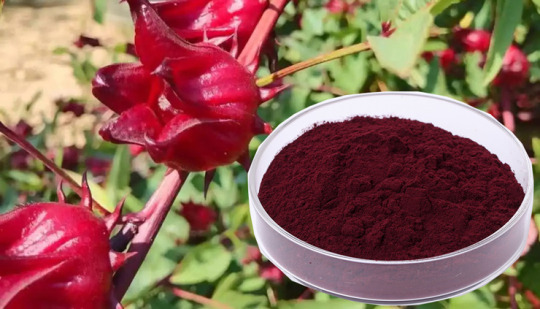
Extract Processing Countries
Besides raw material production, countries like China, the U.S., and Germany import roselle for advanced processing into high-value extracts (e.g., anthocyanins, organic acids) before re-exporting globally.
Introduction to Roselle Extract
Roselle extract is derived from the flowers of Hibiscus sabdariffa (Malvaceae family). It has various health benefits, including:
Calming liver fire
Reducing inflammation
Quenching thirst
Lowering blood pressure and lipids
Improving mental clarity
Eliminating free radicals
Applications in Food & Beverages
Roselle is a rising ingredient in food industries. Its calyx can be used in:
Jams, candied fruits, high-end beverages
Cold/hot teas, sodas, ice creams, cakes
Canned foods, wines, champagnes
Natural food colorants (vibrant red pigment)
Nutritional supplements (rich in vitamin C for children & elderly)
Active Compounds
Roselle contains:
Proteins, organic acids, vitamin C, amino acids
Natural pigments & minerals
Fresh calyx composition:
Vitamin C (0.93%), Vitamin B (0.21%), protein (0.45%), pectin (1.39%)
Sugars (2.55% as glucose), starch (1.76%), carotenoids (0.01%)
Dried calyx composition:
Anthocyanins (1–1.5%), organic acids (10–15%, e.g., citric & hibiscus acids)
Reducing sugars (16%), fiber (11%), 17 amino acids (~1%)
Additional bioactive compounds:
Flavonoids, glycosides, phenols, alkaloids, resins

Health Benefits & Nutritional Value
Roselle is rich in antioxidants (vitamin C & anthocyanins), which combat free radicals, slow aging, and boost immunity.
Key Findings (2024 Studies)
Cardiovascular Health: Anthocyanins help lower blood pressure, especially in hypertensive patients.
Liver Protection: Extracts enhance detoxification and repair damaged liver cells.
Diabetes Management: Regular consumption stabilizes blood sugar levels.
Extraction Methods
Water extraction (cost-effective for polysaccharides & alkaloids)
Ultrasonic extraction (efficient for large-scale production)
Microwave extraction (preserves bioactive compounds)
Pharmacological Effects of Roselle
Modern research highlights its bioactive components:
Phenolic acids (e.g., protocatechuic acid)
Flavonoids (e.g., hibiscetin, quercetin)
Anthocyanins (e.g., delphinidin-3-sambubioside, cyanidin-3-sambubioside)
Organic acids (e.g., citric, hibiscus, tartaric acids)
Proven Benefits
Antihypertensive Effects
A 4-week trial (39 patients) showed reduced systolic BP (139.05 → 123.73 mmHg) and diastolic BP (90.81 → 79.52 mmHg).
Mechanism: Vasodilation + ACE inhibition via anthocyanins.
Antidiabetic Effects
A 14-day study (diabetic women) found lowered fasting glucose (111.25 → 88.58 mg/dL) due to flavonoid-induced enzyme inhibition.
Lipid Reduction
Roselle powder decreased cholesterol, triglycerides, and LDL in obese subjects.
Kidney Protection
28-day consumption reduced creatinine, uric acid, and albuminuria in diabetic nephropathy patients.
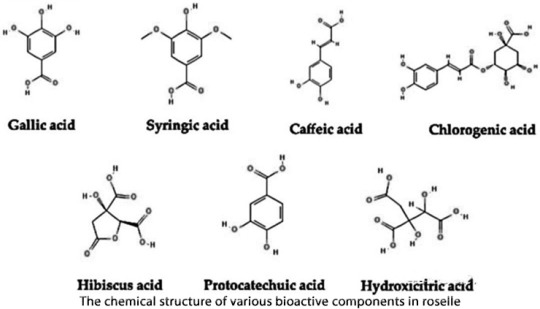
Hibiscus sabdariffa, Roselle Extract
0 notes
Text
C3G: Unlocking Better Metabolic Health
Exploring C3G: A Natural Compound for Enhanced Metabolic Health Introduction C3G, or cyanidin-3-glucoside, is a powerful anthocyanin found in various fruits and vegetables, particularly in blackberries, blueberries, and cherries. This vibrant pigment not only contributes to the rich colors of these foods but also offers a myriad of health benefits. Recent research has highlighted C3G’s role in…
0 notes
Text
Exploring American Elderberry Compounds for Antioxidant, Antiviral, and Antibacterial Properties Through High-Throughput Screening Assays Combined with Untargeted Metabolomics
American elderberry (Sambucus nigra subsp. canadensis) is a rapidly emerging new perennial crop for Missouri, recognized for its high level of bioactive compounds with significant health benefits, including antimicrobial, antiviral, and antioxidant properties. A high-throughput screening assay combined with untargeted metabolomics analysis was utilized on American elderberry juice from 21 genotypes to explore and characterize these bioactive compounds. Our metabolomics study has identified 32 putative bioactive compounds in the American Elderberry juices. An array of high-throughput screening bioassays evaluated 1) total antioxidant capacity, 2) activation of antioxidant response elements (ARE), 3) antiviral activity, and 4) antibacterial activity of the putatively identified compounds. Our results revealed that 14 of the 32 American elderberry compounds exhibited strong antioxidant activity. Four compounds (isorhamnetin 3-O-glucoside, kaempferol, quercetin, and naringenin) activated ARE activity and were found to be non-cytotoxic to cells. Notably, six of the 32 compounds demonstrated significant antiviral activity in an in vitro TZM-bl assay against two strains of HIV-1 virus, CXCR4-dependent NL4-3 virus and CCR5-dependent BaL virus. Luteolin showed the most potent anti-HIV activity in an in vitro TZM-bl assay against the NL4-3 virus (IC50 = 1.49 microM), followed by isorhamnetin (IC50 = 1.67 microM). The most potent anti-HIV compound against the BaL virus was myricetin (IC50 = 1.14 microM), followed by luteolin (IC50 = 4.38 microM). Additionally, six compounds were found to have antibacterial activity against gram-positive bacteria S. aureus, with cyanidin 3-O-rutinoside having the most potent antibacterial activity in vitro (IC50 = 2.9 microM), followed by cyanidin 3-O-glucoside (IC50 = 3.7 microM). These findings support and validate the potential health benefits of compounds found in American elderberry juices, and highlight their potential for use in dietary supplements as well as innovative applications in health and medicine. http://dlvr.it/TDFrpc
0 notes
Text
Kuromanin Chloride (Highly Pure)
Kuromanin Chloride (Highly Pure) Catalog number: B2017010 Lot number: Batch Dependent Expiration Date: Batch dependent Amount: 10 mg Molecular Weight or Concentration: 7084-24-4 Supplied as: Powder Applications: a molecular tool for various biochemical applications Storage: -20°C Keywords: Cyanidin 3-glucoside Grade: Biotechnology grade. All products are highly pure. All solutions are made with…
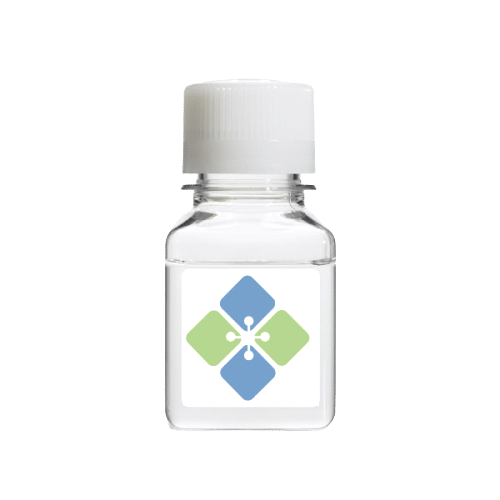
View On WordPress
0 notes
Text
Horticulturae, Vol. 10, Pages 651: Integrated Metabolomic and Transcriptomic Analyses Reveal the Regulatory Mechanism Underlying the Accumulation of Anthocyanins in Cornus officinalis pericarp
The mature flesh of Cornus officinalis exhibits a vibrant red color, attributed to its rich anthocyanin content, imparting significant edible and medicinal value. Vibrant colors not only enhance the visual allure of medicinal materials but also maintain a close association with their intrinsic quality. However, the intricate process of pigment formation governing the anthocyanin accumulation in the pericarp of Cornus officinalis remains poorly understood. In this study, we conducted the comprehensive sampling and analysis of pericarp tissues at three distinct developmental stages, employing morphological-structure observation and metabolomic and transcriptomic techniques. Our findings reveal a substantial increase in the anthocyanin accumulation during the transition to the red stage of Cornus officinalis fruit maturation. Metabolomic profiling identified the highest expression levels of Cyanidin-3-O-glucoside and Pelargonidin-3-O-rutinoside during the mature stage, suggesting their association with the red coloration of the fruit. Through #RNA sequencing, we identified 25,740 differentially expressed genes (DEGs), including 41 DEGs associated with anthocyanin biosynthesis. The correlation between the DEG expression levels and anthocyanin content was explored, further elucidating the regulatory network. Additionally, we validated the pivotal role of the candidate gene BZ1 in the synthesis of Cyanidin-3-O-glucoside through qRT-PCR, confirming its crucial impact on anthocyanin accumulation. This study provides preliminary insights into anthocyanin accumulation in Cornus officinalis, laying the foundation for the future development of new cultivars with enhanced anthocyanin contents. https://www.mdpi.com/2311-7524/10/6/651?utm_source=dlvr.it&utm_medium=tumblr
0 notes
Text
Cannabis Flavonoids: What Are and What Do They Do? A Complete Guide
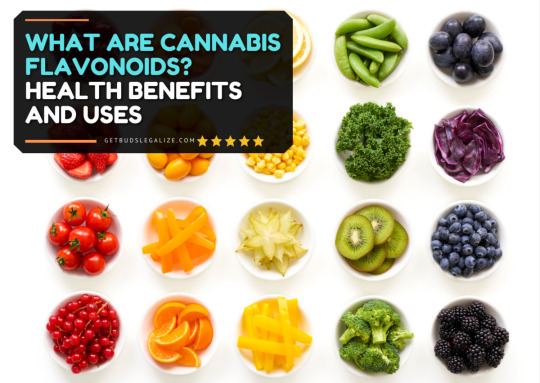
Exploring The Colorful World of Cannabis Flavonoids
Cannabis, with its complex chemistry, offers a treasure trove of compounds that contribute to its diverse effects and potential health benefits. Among these are flavonoids, a class of plant compounds known for their various physiological effects and contributions to flavor and color in many fruits, vegetables, and herbs.What Are Flavonoids in Cannabis?Flavonoids are a diverse group of phytonutrients (plant chemicals) found in fruits, vegetables, grains, tea, wine, and many other plant-based foods. They are responsible for the vivid colors of many fruits and flowers, ranging from red to blue to yellow. Flavonoids are renowned for their antioxidant properties, which means they help protect the body from oxidative stress and inflammation by scavenging harmful free radicals.There are several subclasses of flavonoids, including flavonols (e.g., quercetin, kaempferol), flavones (e.g., apigenin, luteolin), flavanones (e.g., hesperidin, naringenin), flavan-3-ols (e.g., catechins, epicatechins), anthocyanidins (e.g., cyanidin, pelargonidin), and isoflavones (e.g., genistein, daidzein). Each subclass has its unique properties and potential health benefits.What Role Do Flavonoids Play In Cannabis Plants?Flavonoids play several important roles in marijuana plants, contributing to their overall health, protection, and functionality. Here are some key roles that flavonoids play in cannabis:
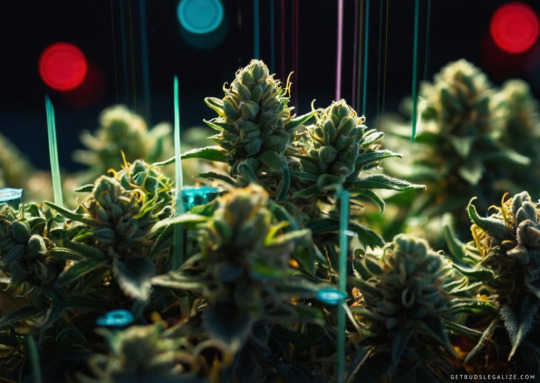
1. UV Protection:Flavonoids act as natural sunscreen for marijuana plants. They absorb ultraviolet (UV) radiation, protecting the plant's delicate tissues from damage caused by excessive exposure to sunlight. This is particularly important for outdoor-grown marijuana plants, which are exposed to varying levels of UV radiation depending on environmental factors.2. Antioxidant Defense:Cannabis flavonoids possess antioxidant properties, meaning they can neutralize harmful free radicals in the plant's cells. Free radicals are unstable molecules that can cause oxidative stress and damage to cellular structures. By scavenging free radicals, flavonoids help protect marijuana plants from oxidative damage and maintain their overall health and vitality.3. Pigmentation:Flavonoids contribute to the pigmentation of flowers and leaves. They are responsible for producing the various colors observed in marijuana plants, including purple, blue, red, and orange hues. The specific combination and concentration of flavonoids present in a cannabis strain determine its unique color profile, which can be influenced by factors such as genetics, environmental conditions, and nutrient availability.4. Anti-Microbial Defense:Flavonoids have been shown to exhibit antimicrobial properties, helping marijuana plants defend against bacterial, fungal, and viral pathogens. By inhibiting the growth of harmful microorganisms, flavonoids contribute to the plant's immune response and resistance to diseases and infections.5. Pollination Attraction:Some flavonoids may play a role in attracting pollinators to cannabis flowers. By emitting specific scents and colors that appeal to bees, butterflies, and other pollinating insects, flavonoids help facilitate the pollination process, which is essential for the reproduction and genetic diversity of marijuana plants.Overall, flavonoids are integral components of the complex chemical profile of cannabis plants. Alongside cannabinoids and terpenes, they contribute to the plant's therapeutic properties, sensory characteristics, and overall resilience in natural environments.As our understanding of cannabis chemistry continues to evolve, further research into the specific roles and effects of flavonoids in cannabis plants may uncover additional insights into their potential benefits for human health and wellness.
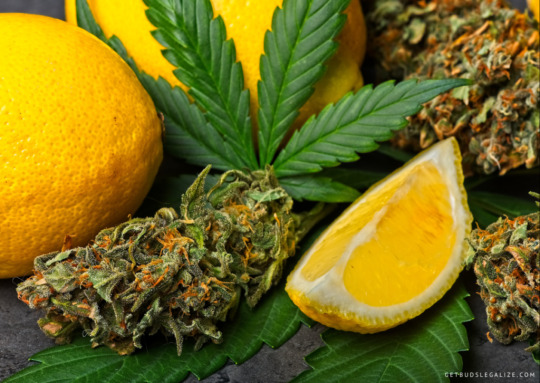
What Potential Health Benefits Do Cannabis Flavonoids Offer?Flavonoids, while less studied compared to cannabinoids like THC and CBD have shown promising benefits. Here are some potential benefits associated with their use:1. Anti-inflammatory properties:Flavonoids in cannabis, such as cannaflavins A and B, have demonstrated strong anti-inflammatory effects. These compounds may help reduce inflammation, which is implicated in various chronic diseases like arthritis, cardiovascular disease, and neurodegenerative disorders.2. Antioxidant activity:Flavonoids are antioxidants that neutralize harmful free radicals in the body. They may protect against chronic diseases such as cancer and cardiovascular disease by preventing oxidative damage to cells.3. Neuroprotective effects:Some flavonoids, such as apigenin, have shown neuroprotective properties in preclinical studies. These compounds may help protect brain cells from damage caused by oxidative stress, inflammation, and neurodegenerative diseases like Alzheimer's and Parkinson's.4. Anti-cancer potential:Certain flavonoids found in cannabis, such as apigenin and quercetin, have been studied for their potential anti-cancer effects. These compounds may inhibit the growth and spread of cancer cells, induce apoptosis (cell death) in cancer cells, and prevent angiogenesis (forming new blood vessels that feed tumors).5. Cardiovascular support:Flavonoids like quercetin have been associated with cardiovascular benefits, including improved blood flow, reduced blood pressure, and protection against heart disease. These effects may be attributed to their anti-inflammatory and antioxidant properties.6. Anti-allergic properties:Some flavonoids, such as cannflavin A, have been found to exhibit anti-allergic effects by inhibiting the release of histamines and other inflammatory mediators. This could potentially benefit individuals with allergies or allergic conditions.It's important to note that much of the research on flavonoids is still in its early stages, and more studies are needed to fully understand their potential health benefits and mechanisms of action.Additionally, the effects of flavonoids may vary depending on factors such as the specific compounds present, their concentrations, and how they interact with other components of the cannabis plant. Flavonoids and Endocannabinoid System
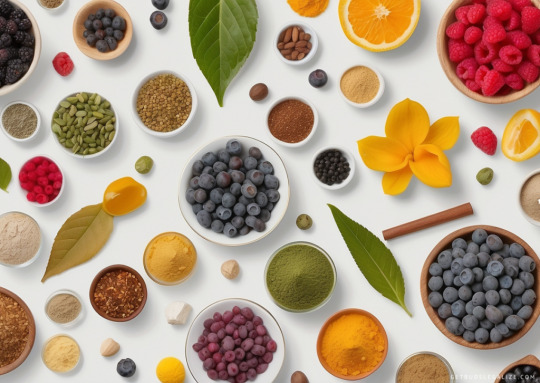
Some research suggests that certain flavonoids found in cannabis may interact with the ECS, which is a complex network of receptors, enzymes, and endocannabinoids that play a crucial role in regulating various physiological processes, including mood, memory, appetite, and pain sensation.For instance, flavonoids like quercetin and kaempferol have been found to have a mild affinity for cannabinoid receptors, particularly CB2 receptors, which are primarily located in immune cells and tissues associated with inflammation. By interacting with these receptors, flavonoids may modulate immune responses and inflammation.Moreover, flavonoids can also influence the activity of enzymes involved in the synthesis and degradation of endocannabinoids, such as fatty acid amide hydrolase (FAAH) and monoacylglycerol lipase (MAGL). By regulating the levels of endocannabinoids like anandamide and 2-arachidonoylglycerol (2-AG), flavonoids may indirectly affect ECS signaling and function.However, it's important to note that research on flavonoids and their interaction with the ECS is still in its early stages, and much more investigation is needed to fully understand the mechanisms and potential therapeutic applications.Additionally, the effects of flavonoids can vary depending on factors such as their concentration, the presence of other cannabis compounds (like cannabinoids and terpenes), and individual differences in metabolism and physiology.List Of Flavonoids In Cannabis And Their Potential BenefitsCannabis contains a variety of flavonoids, although research on them is still ongoing. Some of the flavonoids identified in cannabis include: 1. Cannflavins:
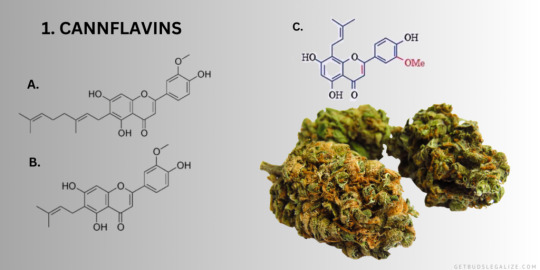
Among the unique flavonoids found in cannabis are the cannflavins, namely Cannflavin A, Cannflavin B, and Cannflavin C. These compounds have garnered attention for their potential anti-inflammatory properties. Cannflavin A, in particular, has shown promise in preclinical studies for its potent anti-inflammatory effects, surpassing those of aspirin in some research. 2. Apigenin:
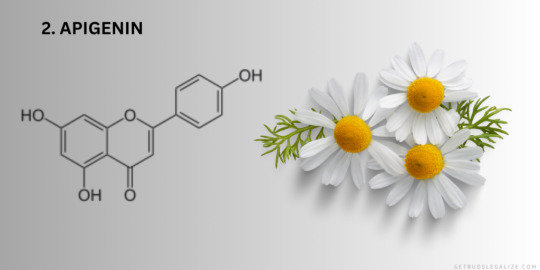
Another noteworthy flavonoid present in cannabis is apigenin. This compound is widely known for its anti-inflammatory and antioxidant properties. Studies suggest that apigenin may contribute to the overall therapeutic effects of cannabis, potentially enhancing its medicinal value. 3. Luteolin:
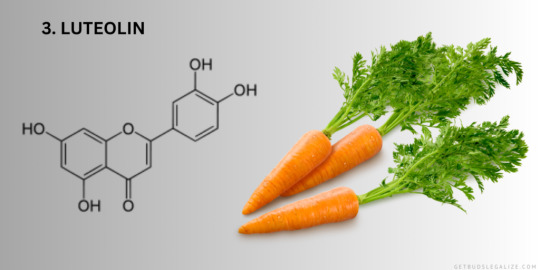
Luteolin is a flavone commonly found in various plants, including cannabis. Studies suggest that luteolin may exert neuroprotective, anti-inflammatory, and anticancer effects. Its presence in cannabis adds to the diverse array of compounds that contribute to the plant's medicinal properties. 4. Kaempferol:
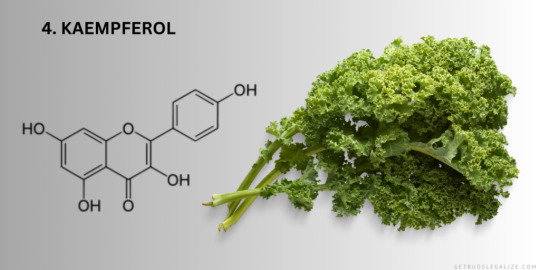
Kaempferol is another flavonoid identified in cannabis, celebrated for its potential health benefits. Research indicates that kaempferol may possess anti-cancer, anti-inflammatory, and neuroprotective properties, making it a compound of interest in the realm of medicinal cannabis. 5. Quercetin:
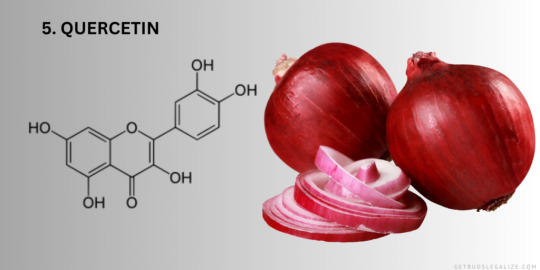
Quercetin is a flavonoid abundant in various fruits and vegetables, including cannabis. Known for its antioxidant and anti-inflammatory properties, quercetin has been investigated for its potential role in supporting cardiovascular health and reducing inflammation-related conditions. 6. Orientin:
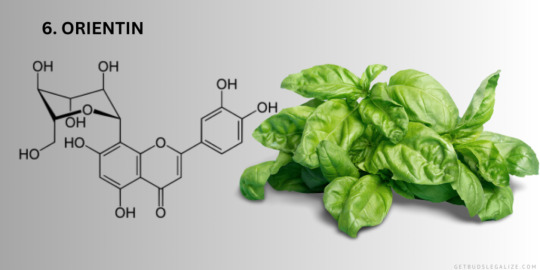
Orientin, while less studied compared to some other flavonoids, is also present in cannabis. It belongs to the flavone class of flavonoids and has demonstrated antioxidant and anti-inflammatory effects in preliminary research. Further exploration is warranted to uncover its full therapeutic potential. 7. Vitexin and Isovitexin:
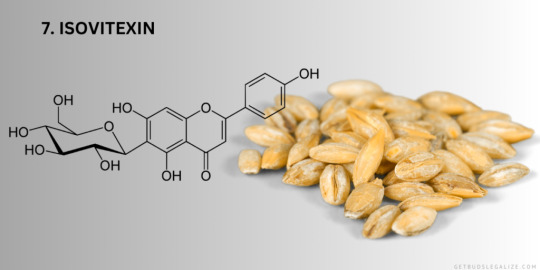
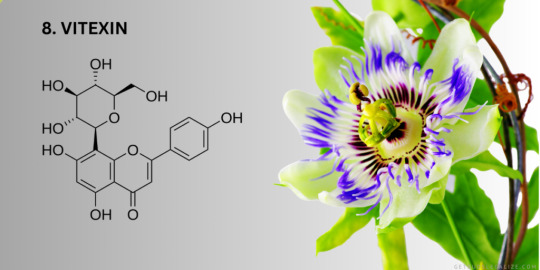
Vitexin and its derivative, isovitexin, are flavonoids found in cannabis with potential health-promoting properties. These compounds have been investigated for their antioxidant, anti-inflammatory, and neuroprotective effects. While research on vitexin and isovitexin in cannabis is still emerging, their presence underscores the complexity of the plant's chemical composition. Flavonoids vs Terpenes: What Are The Differences? Read the full article
0 notes
Text




4 notes
·
View notes
Text
I hate when people are like “oh don’t eat anything you can’t pronounce the name of! All those chemicals! Eat some fruit.”
like can you pronounce “quercetin-3-galactoside, quercetin-3-glucoside, quercetin-3-rhamnoside, catechin, epicatechin, procyanidin, cyanidin-3-galactoside, coumaric acid, chlorogenic acid, gallic acid, and phloridzin?”
No? Well those are all chemicals found in an apple so yk, maybe it’s not as serious as you thought Bestie
(If any of the chemicals are wrong, it’s cuz google betrayed me)
0 notes
Text
CÂY ĐỖ QUYÊN CHỮA NẤM TÓC
Đặc tính: Đỗ quyên có tên khoa học là Rhododendron Simsii Planch, còn gọi là sơn thạch lựu, ánh sơn hồng, mãn sơn hồng, báo xuân hoa, thanh minh hoa, sơn trà hoa… Dân gian thường thu hái hoa vào mùa xuân, lá vào mùa hạ và rễ vào mùa đông đem phơi khô trong bóng râm hoặc dùng tươi để làm thuốc. Trong hoa chứa nhiều anthocyanin và flavonoid, anthocyanin thường thấy nhất là cyanidin 3-glucosid và cyanidin 3,5-diglucosid. Flavanoid thường thấy nhất là azaleatin 3-fhamnóyi glcosid. Trong lá và cành non có chứa Flayonoid, coumarin, triterpen, organic acid, amino acid, tamin, phenol, stenol, cardiac, glycosid, volatil oil …; riêng lá còn chứa cersolic acid và andromedotoxin. Hoa đỗ quyên vị chua ngọt, tính ấm, có công dụng hoà huyết, điều kinh, trừ đàm chỉ khái, khử phong thấp và làm hết ngứa, được dùng để chữa các chứng rối loạn kinh nguyệt, bế kinh, băng lậu, tổn thương do ngã, phong thấp, thổ huyết, nục huyết… Lá có vị chua, tính bình, có công dụng thanh nhiệt, giải độc, cầm máu chủ trị ung thũng, mụn nhọt, xuất huyết do chấn thương, dị ứng, viêm khí phế quản… Rễ vị chua ngọt, tính ấm, có công dụng hoà huyết, chỉ huyết, trừ phong thấp, giảm đau, được dùng để chữa các chứng xuất huyết, kinh nguyệt không đều, băng lậu, trĩ xuất huyết, lỵ, viêm khớp, thương tổn do ngã…
Công dụng:
Viêm khí phế quản mạn tính:
Nôn ra máu, chảy máu mũi:
Chữa nấm tóc:
Viêm loét đạ dày:
Chữa áp xe vú giai đoạn viêm tấy:
Viêm bạch mạch do giun chỉ:
Khí huyết không đều:
Rong kinh:
Chữa chứng đau bụng của sản hậu:
Chữa chứng xuất huyết sản hậu:
Chữa rối loạn kinh nguyệt:
Chữa chứng lòi dom:
Chữa dị ứng:
Chữa mụn nhọt và viêm loét vùng gáy (đối khẩu sang):
Ung nhọt và viêm loét phần mềm:
Trị vết thương do ngã:
Bất tỉnh nhân sự do quá sợ hãi hoặc chấn thương cơ học:
NguyênLiệuLàmThuốc #CầmMáu #ChữaBệnhPhụNữ #ChữaBệnhTrĩ #ChữaĐauDạDày #ChữaMụnNhọtMẩnNgứa #ChữaViêmPhếQuản #TrịGiunSán
#lamthuoc.net-nguyên liệu làm thuốc#cầm máu#chữa bệnh phụ nữ#chữa bệnh trĩ#chữa đau dạ dày#chữa mụn nhọt mẩn ngứa#chữa viêm phế quản#trị giun sán
0 notes
Text
What You Need To Learn About The Benefits Of Blood Pressure Supplements

Blood pressure levels are an important health concern However, it is possible to lower the diastolic as well as systolic blood pressure through regular exercise, adhering to a healthy diet low in sodium, managing stress and losing weight. Certain medications can aid in managing blood pressure naturally.
Folic acid is an B vitamin that is commonly given during pregnancy to protect women from birth defects. It could also assist in decreasing high blood pressure.
Omega-3 Fatty acids
A staggering one out of three people suffer from high blood pressure. And a new study suggests that omega-3 fatty acids may help. Researchers reviewed 71 published clinical trials that looked at the effects of taking supplements with fish oil or meals high in omega-3 fatty acids, particularly docosahexaenoic acids (DHA) and eicosapentaenoic acid (EPA). Researchers discovered that individuals who took in DHA or EPA often experienced a reduction in both systolic (high blood pressure) as well as diastolic (low blood pressure).
Scientists believe that consumption of omega-3 fatty acids decreases blood pressure through directly affecting large-conductance calcium dependent potassium channels in vascular muscles. They regulate the control of secretion as well as cell function.
Aside from the cardiovascular benefits, omega-3 fatty acids are known for their role in brain health, fetal development, the health of your eyes, weight loss and much more. Similar to all nutritional supplements, it's best to talk to your doctor or health professional to review the most recent research findings and get advice regarding the most effective way to incorporate omega-3s into your food regimen. In https://www.dziennikwschodni.pl/artykuly-sponsorowane/ultra-cardio-x-kapsulki-na-nadcisnienie-opinie-sklad-cena-kapsulek,n,1000321864.html, you can easily understand hypertension.
Green Tea
The leafy leaves from Camellia sinensis are used make green tea. As it's not treated as oolong or black, green tea contains more antioxidants as well as polyphenols. Green tea can be used to manage a range of health conditions, including hypertension and liver disease. Also, it has been proven to lower the chance of pancreatic cancer.
A study of a large scale found that people who drank the majority of green tea were twice less likely to be diagnosed with pancreatic cancer when compared to non-drinkers. More research will be needed to determine if this decreases stomach cancer and other types of cancers too.
Green tea is a source of caffeine which can increase blood pressure if consumed in excess. Consult your physician before making it a regular part of your diet, especially in the case of medications that affect blood pressure, such as beta-blockers. The caffeine in coffee can affect the effectiveness of some drugs.
Hibiscus Tea
Hibiscus is a great source of vitamins, minerals and nutrients. Additionally, it has diuretic properties which encourage urination. It can also assist in reducing blood pressure. It also has a flavonoids called delphinidin and cyanidin-3-sambubioside which have been shown to relax the tension of blood vessels, decreasing blood pressure.
The tropical leaf of this plant is full of antioxidants and polyphenols which have been proven to be efficient in the fight against cancer. In test-tube studies, hibiscus extract was able to slow down the growth of mouth cancer cells and prostate cancer.
For best results, drink three cups of hibiscus tea per daily. For the drink make sure to cover one tablespoon of dried hibiscus with 8 ounces of boiling water and let it sit for around 10 minutes. After straining out the petals, you can drink it cold or warm. The drink can be sweetened by adding a teaspoon of honey, or add a dash of lime to enhance the flavor.
Vitamin D
Vitamin D is a group of secosteroids, which have fat soluble properties. Vitamin D regulates calcium levels and blood pressure levels in the body. Deficiency in vitamin D is linked with high blood pressure along with high cholesterol levels and other health problems.
Researchers have discovered that lower levels of vitamin D have been linked with hypertension, heart disease and different conditions. However, the reason of this has not been identified. Low vitamin D is also related to a higher risk of developing rickets. This is a disease that is preventable with frequent exposure to sunlight, as well as vitamin D-enriched foods.
According to several research investigations, it has been found that vitamin D can reduce systolic and diastolic pressure. You should consult with your physician prior to deciding to consume vitamin D supplements since it can interfere with certain medication. It may reduce the effectiveness of blood pressure medicines like diuretics containing thiazide (Hygroton, Lozol) and verapamil (Cardizem, Tiazac). Long-term use of stimulant laxatives may also reduce the absorption of vitamin D.
0 notes
Text
Anthocyanins are the pigments responsible for the blue and purple color in some berries (Figure 21.36).
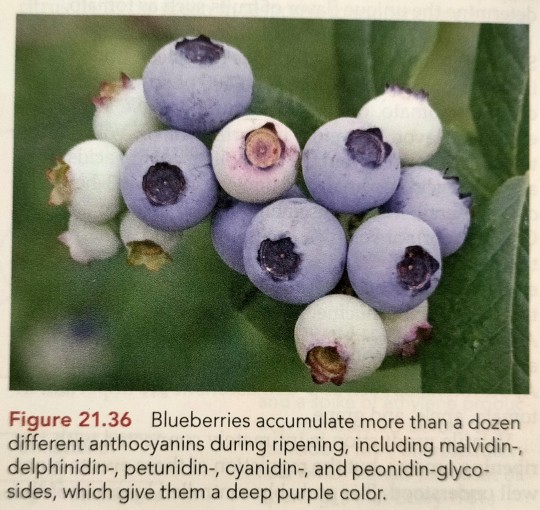
"Plant Physiology and Development" int'l 6e - Taiz, L., Zeiger, E., Møller, I.M., Murphy, A.
#book quotes#plant physiology and development#nonfiction#textbook#anthocyanin#blueberry#glycoside#malvidin#delphinidin#petunidin#cyanidin#peonidin#purple#blue
0 notes